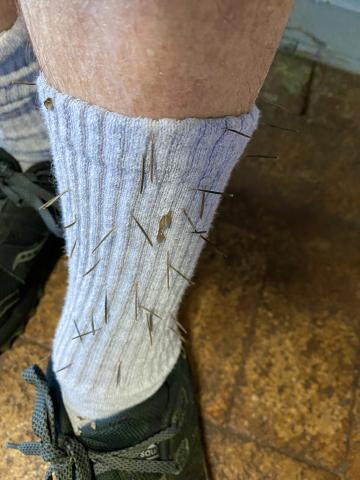Hitchhiking Plants

Clingy seeds like these Spanish needles are a nuisance after an outdoor hike, but demonstrate a very effective means of dispersal away from the mother plant
By Steve Roark
Volunteer Cumberland Gap National Historical Park
A lot of my trips into the wild come with the obligatory ritual of pulling off seeds stuck to my clothes. This is especially true in the fall and winter, when the seeds are mature and easily dislodged from their mother plant. Most of these hitchhiking seeds use the Velcro method of grabbing hair or clothing. They use small barbs or hooks that adhere to whatever brushes against them. The inventor of Velcro did in fact got the idea from these sticky plants. Grabbing onto animals (and humans) is how these innovative plants get their seeds dispersed far and wide. Here is a description of several seeds you are most likely to find stuck to your socks.
Beggar ticks (Biden species): There are around 25 different species of this kind of plant and have names like Spanish needles and beggar lice. The seeds vary in shape from needle-like to flat with one end wide and one narrow. They have at least 2 barbs on one end of the seed that are covered with tiny backward-directed hairs like the points of a harpoon. The seeds are arranged on the winter plant stalk with the barbs projecting outward.
Sticktights (Desmodium species): Other names include Tick-trefoil and seed tick. These are the ones that don’t have barbs but have flat, triangular seeds that have a covering of fuzz that adheres to clothing. The seeds are joined in short rows on the plant and look like tiny pea pods. This seed has limited wildlife use, except for Quail, that really like them.
Burdock (Arctium species): These seeds are small round burs with a surface covered with small, recurved hooks that really grab and hold on tighter than all of the hitchhiking seeds. Burdock is a native of Europe and Asia. The large root of the burdock is edible in the winter and has also been used as a medicinal.
Cocklebur (Xanthium species): This one is a North American native and is often found at lakesides and waste places. The seeds look like small brown footballs covered with hooks.
Hitchhiking seeds are even worse of a problem when wearing fluffy clothing like fleece or polyester. If your pants are absolutely covered with seeds, try taking a knife to carefully scrape them off. And don’t pick them off and then drop them on your property unless you want more of them.
- Log in to post comments